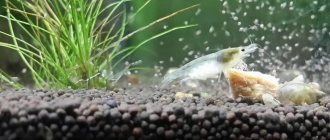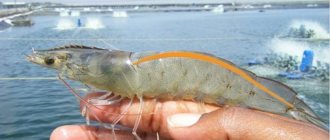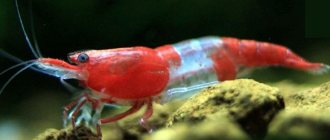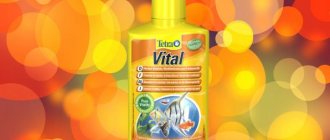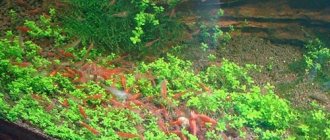Home › Aquarium shrimp › Types of aquarium shrimp ›
( 1 ratings, average: 3.00 out of 5)
Red fire (Neocaridina heteropoda var. Fire Red) is one of the most popular dwarf freshwater aquarium shrimp of the Neocaridina genus. There are several gradations of the color of the fiery red look: red sakura (Sakura), red fire (Fire Red), bright fire red (Painted Fire Red). These are all selectively bred color morphs of Neocaridina heteropoda, grouped under the species Red Fire aquarium shrimp. All of them are very similar in lifestyle, content and appearance to the aquarium cherry shrimp (Red Cherry).
Color gradations
You can read in detail about all the available gradations of red cherry shrimp in the article on classification.
Sakura Red Shrimp
The female's body is almost entirely red, there may be some translucent areas near the underbelly, and the saddle may be visible. Clefts in the shell may be visible.
Males are similar to male cherry shrimp and can be almost colorless.
Fire Red Shrimp
The body and legs are red, without the formation of clefts on the shell. There may be some minor lightening on the legs, but overall they should be red. Some translucency of the carapace is still possible, so that the saddle is still visible, but in poor light it is difficult to see.
Taiwan Fire Red Shrimp
Very similar to fire shrimp, except for two notable features. Firstly, Taiwanese shrimp have a clear uniformity of color, with red covering all visible parts of the shrimp. Secondly, they have a higher percentage of offspring with similar characteristics than regular fiery reds, approximately 80-90% similar.
This morph has a deeper dark color in both males and females. The saddle is rarely visible, even under direct light, and the males look approximately like a high-grade red cherry tree, and may even be colored like the female.
Variable features of some shrimp Neocaridina davidi
The tables show variations with less or more intense orange, pink, red color, etc. You can also see variations of Neocaridin Riley - these are clear alternating lines of different colors. These variations were released in Taiwan in 2010. At first, Riley was selectively bred from red neocardines with white spots and stripes, from which the Red Riley and Red and Blue variations were obtained. The breeders did not stop there and began to cross different color variations from the “Cherry Family”, obtaining more and more new colors. Let's look at the characteristic features of some variations of the Neocaridina davidi shrimp in more detail.
Red Rili Shrimp
The Red Riley Shrimp has all the characteristics of the Cherry, but also has a transparent middle part. It is as easy to propagate as Cherry, but looks different and is an alternative species. Caviar is yellow in color. It is recommended for beginner shrimp lovers.
Red Rili Blu Shrimp
The head and tail of this shrimp are bright red, while the middle part of the body has a sky blue color, more intense in the upper part. Caviar is yellow in color. The body is completely well painted.
Blue Carbon Rili Shrimp
The head and tail of this neocaridine are black. The black color has a shade of blue, as if covered with blue varnish. The rest of the middle part of the body has a rich transparent turquoise color, along which there are black and blue dots. Undoubtedly a very beautiful shrimp! The pale yellow eggs are very beautifully visible through the turquoise color on pregnant females. Even for a minute it seemed to me that this was an exotic cocktail in a transparent glass. The coloring is very bright and well painted.
Bloody Mary Shrimp
This shrimp has the brightest red color in this "Cherry Family". If you think that Red Fire is the brightest and that it is impossible to find a redder variation, then you need to see the Bloody Mary variation shrimp. Its color is deep red, like blood. Even the male shrimp is a deep red color, which makes them stand out from the “family” since males in other variations are usually less colorful. This shrimp isn't just red...if you look closely at it, you can see that the shell is actually different from the regular high-end Cherry shrimp. Its shell appears translucent, and the red color shines amazingly from inside the shrimp, like red light. Yes, the beauty of this shrimp deserves attention!
Painted Fire Red
This variation of shrimp was the most beautiful and colorful in the Cherry Family, before the advent of Bloody Mary. There is nothing special about this species now, except for a very good red color. The males of these shrimp are less red than the females.
Neocaridina Kanoko
This name translated means a baby deer, that is, a fawn. This shrimp is dark red in color, the darkest of all the red varieties. Along the main color there are small round black spots, like those of a fawn. When females are pregnant, their eggs are black.
Yellow Neocaridina (Yellow)
This variation of shrimp produces a transparent yellow pigment, which gives it its color. The eggs are also colored bright yellow. This neocaridine has no special differences.
Yellow Sakura Shrimp
The Yellow Sakura shrimp is more valuable than the Yellow variety shrimp. It has a golden hue in its color. These shrimp have a stripe running down their back.
Green Jade Shrimp
The color variety of Green Jade shrimp can vary from rich dark green to green-brown shell color. The eggs are dark green. Shrimp have a stripe running down their back. Females have brighter colors than males. Very interesting and also unusual shrimps for our aquariums!
Shrimp Blue Dream
This shrimp has the deepest blue color among the “family”. Their feature is a solid blue color with a black tint. The Blue Velvet variation is a pale blue shrimp; they are not even close to comparable to the Blue Dream variation. In order for shrimp to have such a rich blue color, breeders made selections over several years and they managed to obtain and secure this amazing color.
Blue Diamond Shrimp
This variation was bred by breeders from the Chocolate shrimp variation and is fixed at 80%. The rich turquoise color glows from the inside, along the back there is a stripe of dense blue color. On the sides there are many blue dots on the turquoise background. Very beautiful coloring, but during reproduction, up to 20% of Chocolate shrimp can appear in the offspring.
Shrimp Chocolate (Schoko)
The color of this shrimp is light brown. Along the main color there are lines in the form of cracks from dark brown to black. Full color appears only in adult individuals at 8 - 10 months of age. The young ones are pale in color. Thanks to the glossy sheen running along the shell, the color looks very stylish!
Black Rose Shrimp
The Black Rose Shrimp (Neocaridina davidi Black Rose) is sometimes called "Black King Kong Neo" in Taiwan because it has a very dense black color and is black from head to tail. It is similar to the Taiwanese King Kong shrimp (Caridina cantonensis), but unlike it, it is not so picky and reproduces well. The color of the Black Rose Shrimp can vary from black to red depending on the incident light, as well as its mood. These shrimp look very elegant in an aquarium.
Reproduction
Red fire shrimp reproduce in the same way as all neocaridins, non-stop without much effort: often and under any conditions. Once they reach breeding age, one pair of shrimp, given stable aquarium water conditions, no predators and sufficient food, can produce hundreds of offspring within a few years.
If you buy these red fire shrimp for breeding, it is better to buy 8-10 of them, for guarantee. For breeding, it is advisable to have an aquarium volume of 4 liters per shrimp. The reproduction rate is only slightly lower than that of red cherries, but here the quantity is also influenced by the necessary culling of non-viable offspring and weak color.
Breeding
With the breeding of orange sakura aquarium shrimp, everything is simple - get yourself several representatives of this species in water with any parameters, and they will do everything themselves, and they will reproduce at such a speed that their population will soon increase several times! When one sexually active pair of shrimp is kept in fairly stable water conditions, in the absence of predatory fish species and with sufficient space and food, the pair can produce up to several hundred offspring per year. If you buy these shrimp for breeding, it is advisable to purchase them in quantities of 8-10 pieces to be sure that at least two pairs will be formed. For best breeding, the volume of the aquarium should be at least 30 liters.
By the way, I purchased my orange cherry blossoms a little less than two months ago, out of 10 purchased shrimp, 4 females produced offspring, and one of the babies has already reached the size of the smallest shrimp I bought! And all the females are already back with saddles, which means they are ready for fertilization.
Content
| Aquarium | °C | Carbonate hardness (°dKH) | Total hardness (°dGH) | PH |
| 10-100 liters | 18-29 | 3-15 | 4-8 | 6.6-8.5 |
Almost any mature aquarium is suitable for keeping red fire shrimp. pH can be from 6.6 to 8.5, water is both hard and soft. Like all neocaridines, the Red Fire aquarium shrimp is versatile and hardy, surviving with minimal care. It is preferable that the aquarium has stable water parameters, temperature, live plants, soil and filtration.
Feeding
This species is not picky about food; it will eat most food for aquarium fish and shrimp, as well as peeled vegetables, algae, and sinking food. They will be happy to feast on any biological formations from driftwood, mosses and plants in the aquarium. If the density of shrimp is no more than one per 1 liter of water, and the aquarium is moderately planted with live plants, then the shrimp can easily live for several days and even weeks without additional feeding. If the density is higher, depending on the quantity, the shrimp should be fed every other day, or once a day.
Flowering time
Cherry blossoms begin in January on the island. Okinawa (located in the south) and ends on the island. Hokkaido, thus moving north. The period when this tree blooms largely depends on its species: some plants begin to bloom in winter, others in late spring. For example, such well-known species as:
- Fuyu-Zakura - blooms in the last month of autumn;
- Yama-dzarkura is an early plant, blooms at the end of March;
- Someyoshino - in early April;
- Yae-zakura - in mid-spring;
- Kasumi-zakura - in early May.
When the flower fully opens, it remains that way for about a week. How long it will bloom depends largely on the weather and temperature - the colder it is, the longer you can contemplate sakura flowers. But strong winds and rain, on the contrary, will significantly reduce cherry blossoms.
Hanami Festival
Cherry blossoms in Japan are celebrated at the state level: the official opening of Hanami (“Contemplation of Flowers”) takes place in Tokyo’s main park, Shinjuku, and not only famous politicians, but also members of the imperial family take part in it.
During this period, numerous gardens, parks, squares and other places where cherry trees bloom are visited by a huge number of people; viewing is especially popular in the evening, when the sakura branch is very beautifully illuminated. While contemplating, people have picnics, relax, and often use the Hanami holiday for personal interests - they negotiate, strengthen contacts, and make new acquaintances.
Use of wood in everyday life
The Japanese make sour wine from the fruits of this plant or add it to rice during cooking. They also found a use for leaves and petals - they pickle them, after which the leaves are used as an edible coating for “sakura-mochi” sweets made from rice, and sakura petals do a good job as an odorous seasoning. During the holidays, they are often dipped in boiling water or green tea. When they come into contact with hot water, the sakura petals open and delight guests with their appearance.

